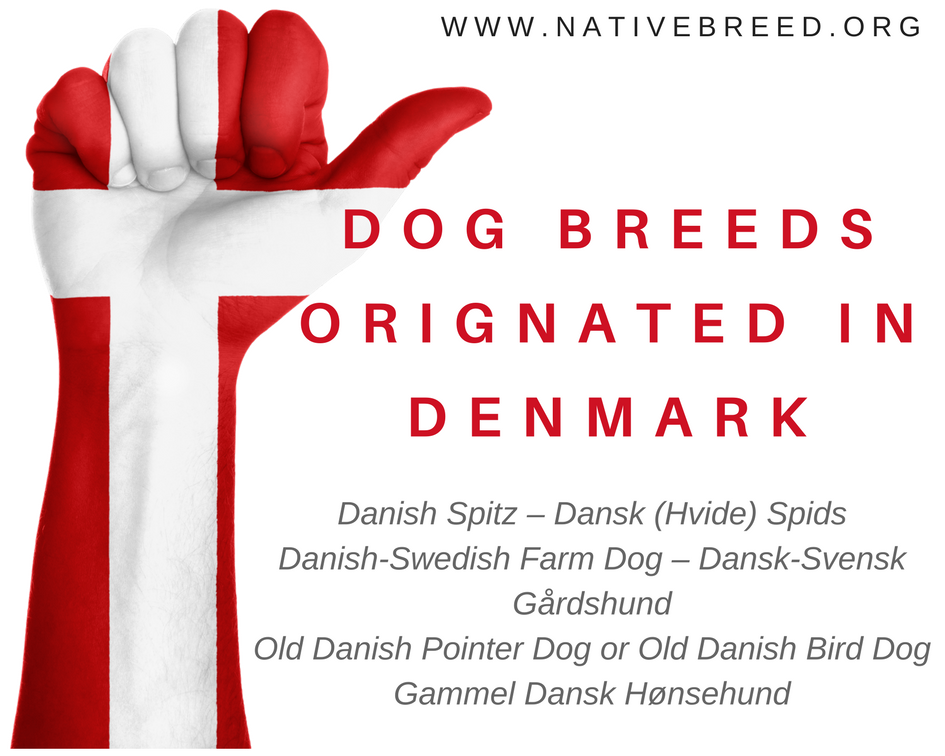Many of today’s breeds originated in Europe. They were principally developed in Great Britain, Germany and France, but it would be hard to find any European country without a national dog breed. Meet the Europeans will explore the history of Danish dog on an old continent full of fanciers.
Meet The Europeans…
Denmark, A Small Country with Six Native Breeds
Danish Spitz
Danish-Swedish Farm Dog
Old Danish Pointer Dog
1. Danish Spitz – Dansk (Hvide) Spids
The Spitz family is a group of breeds that share the same points: relatively small prick ears, tails carried over the back and more or less steep rears. The Danish Spitz is white (in Danish, hvide), about 19 inches (49 centimetres) at the shoulder. At first sight, the Danish Spitz resembles a small Samoyed. The breed is closely related to the German Spitz. Many fanciers believe that the Danish Spitz is a variety of the German Spitz or Dutch Keeshond, but others are convinced that the Danish Spitz is a breed in its own right. Scientists consider Spitz dogs to be one of the oldest, if not the oldest, canine companions that lived in our houses and were part of the family. Information about this Danish dog breed can be confusing; other names, apart from Dansk (Hvide) Spids, are Grønlænderspids, Samojedspids and Ulvesspids (Wolfspitz).
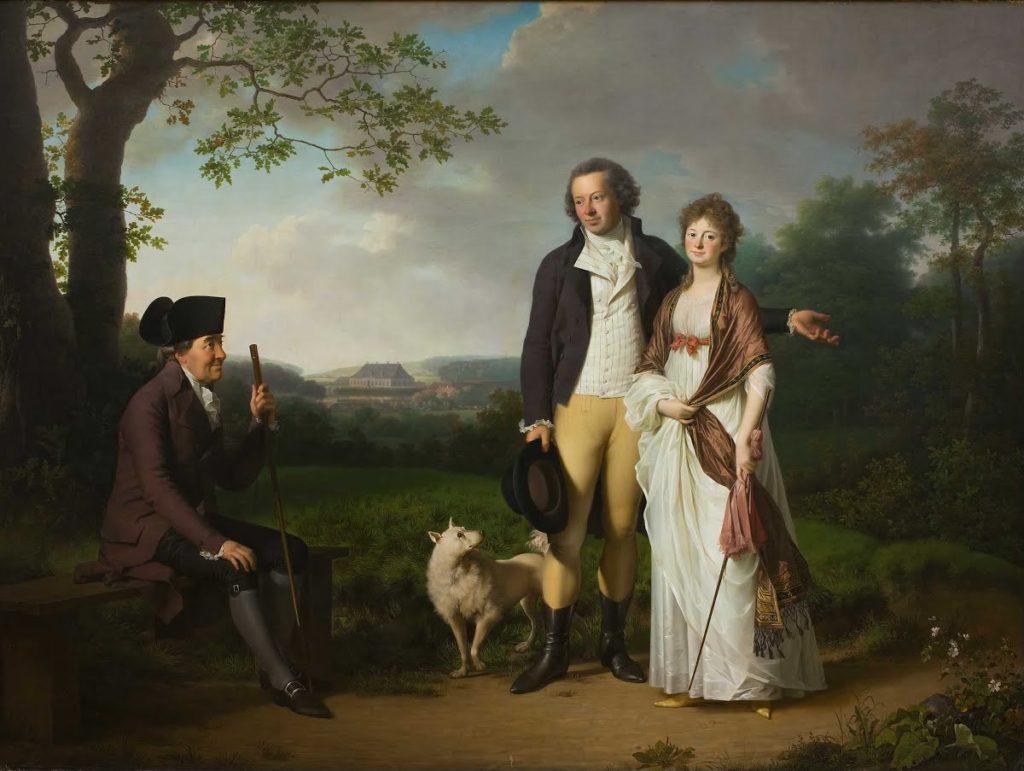
This Danish dog was known in the 1700s as an excellent little guard dog and a good companion. In 1796-97 the breed was painted by Jens Juel (1745- 1802), a Danish artist who represents something close to the high point of 18th-century Danish portrait painting. Niels Ryberg (1725-1804), his son Johan Christian and daughter-law Engelke Ryberg (née Falbe) were portrayed with their lovely Danish Spitz. Ryberg was a trader, shipowner and landowner. In 1960, the painting was acquired by the National Gallery of Art in Copenhagen. The breed was first judged in 1922 when, out of 19 dogs, 12 had enough quality to be registered in a special studbook, the so-called X register. The heyday of the breed was in the 1930s; the Danish Spitz was a common dog at that time especially in Jutland – Jylland in Danish – a peninsula in the northern part of Denmark.
His old job of catching mice and rats has now disappeared for the most part, so this fast little dog must have other things to do.
And again, it was Jytte Weis who, in 1988 on behalf of the Danish Kennel Club, tried to restore the breed – as she had done with the Broholmer – by collecting old depictions and typical dogs.
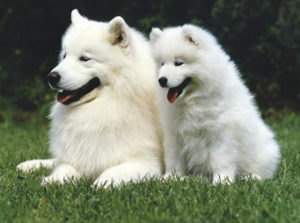 Jack of All Trades
Jack of All Trades
The breed is not associated with the Danish Spidshundeklubben (Spitz Dog Club) but there is a Selskabet for Dansk Spids, a club of fanciers that promotes this old breed. The Selskabet is a member of the Danish Kennel Club. In 2003, the Danish Kennel Club published a provisional breed standard. In August 2013, the Journal of Animal Science published an article about the Danish breeds and came to the conclusion that the Danish Spitz had the most genetic variations compared to the other native Danish dog breeds. The Danish Spitz is a jack of all trades: guard dog, companion dog and working dog. But above all, he is a friendly and curious little dog.
Peat Dog
It is said that the Danish Spitz dates back to the “peat dogs,” the oldest European dog identified by teeth marks left in bones, proving that this prehistoric animal was sharing human food from a very early stage. Peat dogs spread across Europe some 6,000 years ago, the Neolithic period, and remains have been found in the lake dwellings of Switzerland and France. The scientific name for a pet dog is Canis familiaris Palustris, Palustris referring to pile dwellings in Switzerland. On the basis of a skull, Swiss naturalist Ludwig Rütimeyer (1825-95) reconstructed a type of dog with a tapered muzzle, probably Spitz-like in appearance. This Danish dog was medium-sized, had a wide, deep chest, and a thin frame. Later, Rütimeyer’s name was added to the Latin name: Canis familiaris Palustris Rütimeyer.
The Danish Spitz in North America
As far as I could discover, there is no Danish Spitz breed club in the United States or Canada, although it could well be that Danish Spitzes have been imported to North America. If so, please send your information to the author.
The Danish Spitz in Short:
Origin: Possibly the peat dogs that spread across Europe 6,000 years ago
Original purpose: Guard dog, companion
Description: The Danish Spitz is a rectangular dog, slightly longer than tall. Its coat colour is not chalk-white, but varies from white to biscuit, yellowish-cream and sometimes slightly pink. As the dog ages, the coat can become brown, which is not desirable. Around the neck is a ruff. The tail is carried in a curl over the back; a typical characteristic is a tail hanging when the dog is relaxed. Its bone is not heavy, but at the same time not light. Movement is light and effective. The Danish Spitz has brown eyes and a brown nose. The breed is not recognised by the FCI, AKC, CKC, UKC or the American Rare Breeds Association. Information: Danish breed club, in Danish
2. Danish-Swedish Farm Dog
Dansk-Svensk Gårdshund
The FCI, the largest canine organization in the world, has full members, associate members and contract partners (one member per country). Each issues its own pedigrees and trains its own judges. The FCI ensures that the pedigrees and judges are mutually recognized by all FCI members. Recognition of a breed by the FCI means that in almost every European country, that breed can be awarded FCI championship prizes. One of the provisionally recognized breeds is the Danish-Swedish Gårdshund.
Pinschers and Fox Terrairs
For ages, this type of Danish dog was known not only around Danish, southern Swedish and northern German farmhouses but also in the Baltic countries of Estonia, Latvia and Lithuania. They were useful animals–destroyers of vermin such as mice, rats and other small rodents. Somewhere I read: “It keeps the fox away from the chickens and strangers from the premises.” That’s probably why this dog is also named “chicken dog.” Almost nothing is known about their early history, but most dog writers assume that their ancestors were crossings between Pinschers and Fox Terriers. Some are of the opinion that this type of dog has existed for 200 years or more. Others assert that its history goes back to the time of the Vikings and that these dogs were depicted in the 15th century. I did not succeed in finding old Danish or Swedish prints or paintings, and old photographs seem to be extremely rare. Mentally and physically, they most resemble the Fox Terrier, but with a softer temperament; the Danish-Swedish Farm Dog is a friendly and easy-going little dog.
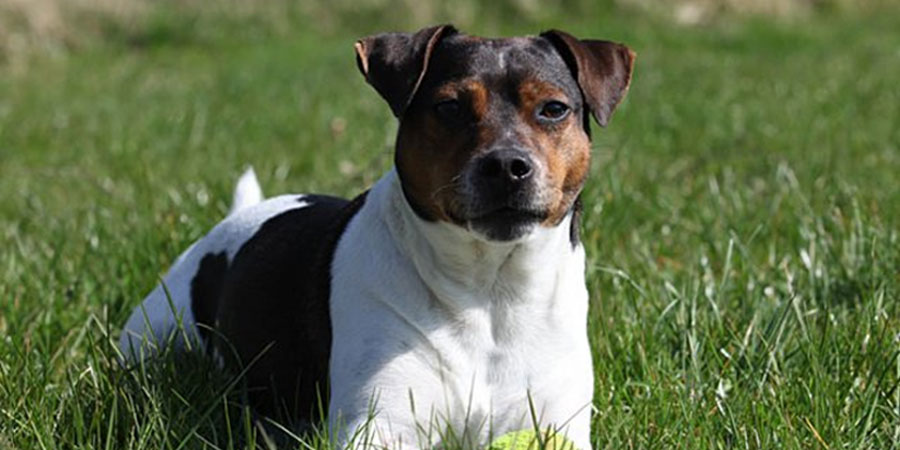
Rudolf Steiner
Rudolf Steiner (1861-1925), an Austrian philosopher and social reformer, is said to have owned the breed. He was photographed twice with a dog, possibly his Pschulek, an old Danish-Swedish Farm Dog. In 1891, Steiner earned a doctorate in philosophy at the University of Rostock, in northern Germany. Rostock is situated exactly in the area where the Danish-Swedish Farm Dog was developed. Steiner was interested in the soul of dogs and gave lectures on this subject: Über das Verhältnis der Tierseele Zur Mensenseele (The relation between animal souls and human souls) and Die Seele der Tiere im Lichte der Geistenswissenschaft (The soul of animals in the perspective of the humanities).
Similar types
In the 1960s, the first attempts were made in Sweden – by the Swedish Dog Club – to gain national recognition for the breed. Because the breed developed separately in Denmark and Sweden, there is no consensus in historical dates. It was only about 30 years ago that the little farm dog was nationally recognized, but still, the sources are not unanimous. In 1983, the first breed club was founded in Sweden: the Rasklubben för Skånsk terrier. In February 1986, at a meeting in Malmö, Sweden, 107 dogs were photographed, filmed and drawn up. At the end of the day, the owners concluded that the dogs were of a similar type, a positive conclusion when it comes to the development of a breed. In Denmark, the dogs have been more-or-less purebred since about 1985. In 1987, the Danish-Swedish Farm Dog was nationally recognized in Denmark and Sweden, by the Danish Kennel Club and the Swedish Kennel Club. The first championship prizes were presented at a show in September 1987. When I saw the breed for the first time at the Danish Kennel Club’s Jubilee Show in 2007, it was difficult to see the difference between the new breed and, for example, the Fox Terrier. I was in good company. In 1989, after the well-known Swiss dog writer Dr Hans Räber visited the World Show in Copenhagen, he wrote about his introduction to the breed: “When I saw the first Danish-Swedish Farm Dog on the showground, I did not dare to ask people the name of the breed – because there was a possibility that they participated in agility or obedience and therefore not necessarily a pedigree dog. When more turned up, I became suspicious! Indeed, they were purebred dogs!”
Ratter
Originally, the Danish-Swedish Farm Dog was a working dog, keeping the farmhouse and stables free of vermin. In northern Germany, especially in the province of Schleswig-Holstein, the “ratter” was a well-known type of dog that could be seen everywhere in the countryside. However, with urbanization, their numbers decreased. In general, the Danish-Swedish Farm Dog is a sturdy dog. The farmers didn’t keep weak puppies; only the strong ones survived and when growing up, they were not pampered. And it was again thanks to the Danish dog fancier Jytte Weiss that this farm dog was saved from extinction. She had become interested in the breed because her parents owned this type of dog. We met Jytte Weiss in the histories of the Broholmer and Danish Spitz. She is certainly a VIP when it comes to preserving Danish heritage. Today, Denmark and Sweden are working hard to save this living piece of history. In the last quarter of the 20th century, fanciers tried to find dogs of a good type. A breed program started with help from the Danish and Swedish Kennel Clubs – both interested in saving endangered national breeds. Luckily, sufficient healthy and typical dogs were found to form the basis of the present population.
Versatile Dog
The Danish-Swedish Farm Dog is a versatile dog. Apart from catching mice and rats, he announces visitors loudly and is a playmate for children. The breed is inquisitive and intelligent and has an uncomplicated character. He is bursting with energy, so agility, flyball and other sports are not wasted on him. His old job of catching mice and rats has now disappeared to a large extent, so this energetic and fast little dog must have other things to do. It is said that, in bygone years, he was also used in circuses. Staying home alone is not his strong point; for years he was a sociable part of the family. The Danish-Swedish Farm Dog is known for its late maturity. At first, he resembles a Smooth Fox Terrier because of his white coat with reddish-brown or black patches. Dog writer Hans Räber mentioned that the relationship with Pinschers is closer than that with terriers. However, as is usual in the history of dogs, other fanciers did not agree. The FCI agreed with Räber and classified the breed in Group 2 (Pinschers and Schnauzers). In literature, the breed is also mentioned as Scanian Terrier or Skånks Terrier (after the province of Skåne in southern Sweden) or, simply, Ratter.
Extensive Information
In Sweden, the breed is promoted by the Swedish Farm Dog and Herding Dog Club (Svenska Gårds- och Vallhundsklubben; sgvk.se); there is extensive information on their website, about the ancestors of the breed, health, and the number of litters born per year. Almost every genetic disorder is under a five per cent occurrence. Allergies and wrong bites were reported among the investigated dogs. The percentage of inbreeding is known thanks to an investigation in 2005. The Department of Zoology and Population Genetics at The University of Stockholm was involved in this project. Abnormalities such as patella luxation and hip dysplasia have to be watched closely. Today, there are estimated to be more than 2,000 DanishSwedish Farm Dogs; about 600 puppies are registered each year. The breed club in Denmark is the Dansk/Svensk Gårdhundeklub, founded in 2002. They told me that the DanishSwedish Farm Dog is the same as the old Danish Fox Terrier, sometimes mentioned in literature.
Resembling Other Terriers
Apart from the Fox Terrier, the Danish-Swedish Farm Dog resembles the Brazilian Terrier. The points in their standards are similar to a large extent. The differences between the Farm Dog and the Fox Terrier – one of its ancestors – and the Russell Terrier are greater. Although all three have white as the basic coat colour, with patches of various colours, there are some notable differences. The Danish-Swedish Farm Dog is small, compact and slightly rectangular. (Russell Terrier: The overall dog is longer than high, i.e., rectangular.) The Farm Dog’s skull is rather broad and slightly rounded; the head is triangular in shape and a bit small in proportion to the body. The stop is well-defined. (Fox Terrier: The skull is flat and moderately narrow with “not much” stop.) The colour of the nose is in accordance with the colour of the patches. The muzzle is well developed and is slightly shorter than the skull. It must not give a snippy appearance. (Russell Terrier: The length from the stop to the nose should be slightly shorter than from the stop to the occiput.) The Danish-Swedish Farm Dog must have a scissor bite, but a pincer bite is tolerated. Its eyes are medium-sized, slightly rounded, neither protruding nor sunken. Dark eye colour in dogs with black patches. Slightly lighter eye colour is permissible in dogs with yellow or liver-brown patches. (Fox Terrier: Dark eyes, moderately small, as near as possible circular in shape.) (Russell Terrier: Eyes are almond-shaped.) The ears are of medium size, rose or button. The fold should be just above the skull. The tips should lie close to the cheeks. (Fox Terrier: Small, V-shaped and dropping forward close to the cheeks.) (Russell Terrier: Button or drop.)
The Danish-Swedish Farm Dog in Short:
Origin: 19th-century – Denmark and Sweden
Original purpose: Vermin-catcher
Description: The Farm Dog’s medium-long neck is strong and slightly arched, without throatiness. (Fox Terrier: Of fair length and gradually widening to shoulders)
Its loin is short, broad and slightly arched. Forelegs straight and parallel. The front is broader than the ribcage. The forefeet are small, oval and not tightly knit. (Russell Terrier: Both front and hind feet are moderate in size, oval-shaped, hard-padded, toes moderately arched.) (Brazilian Terrier: Hare feet, the two median toes are longer.)
The long or naturally short – stumpy – tail is not set too high. The tail should be carried straight, with a slight curve or like a sickle. (Fox Terrier: Set on rather high and carried gaily, but not over the back or curled.) (Russell Terrier: May drop at rest. When moving should be erect and if docked, the tip should be on the same level as the ears.)
The Farm Dog’s coat is short and smooth, but harsh on the body. (Russell Terrier: The coat may be smooth, broken or rough. Must be waterproof.) (Brazilian Terrier: Short-haired, smooth, fine but not soft. It lies close to the skin, like a rat’s hair.)
White is dominant in the Farm Dog coat. The patches can be of different colours, sizes and combinations (black, tan, brown and different shades of brown), with or without tan markings. Flecking is permissible.
In Danish-Swedish Farm Dogs, Russell Terriers, Fox Terriers and Brazilian Terriers, white must be the dominant colour.
Height: The height at the withers is 13 to 14.5 inches (34 to 37 centimetres) for males, 12.5-14 inches (32 to 35 centimetres) for females, with a tolerance of plus or minus three-quarters of an inch (two centimetres). (Russell Terrier: 10 to 12 inches [25 to 30 centimetres], males and females.) (Brazilian Terrier: 14 to 16 inches [35 to 40 centimetres] for males, 13 to 15 inches [33 to 38 centimetres] for females.) (Fox Terrier: Males 15.5 inches [39 centimetres], females proportionately lower.) Some of the faults in DanishSwedish Farm Dogs are an elegant general appearance, narrow in the front, low on legs, lack of depth in the chest, neck too long, flat or short rib cage and a steep croup. Aggression and over-shyness are disqualifying faults. Denmark and Sweden co-own the FCI breed standard.
Information: Danish breed club, in Danish
The Breed in North America
The first Danish-Swedish Farm Dogs in America were imported from Denmark in the late 1990s. The breed was first registered with the American Rare Breeds Association (ARBA). The breed club – Danish/Swedish Farmdog Club of America – was established in 2003 and incorporated in March 2005.
The first Danish-Swedish Farm Dog Specialty was held in 2006, in Colorado, the second in California, in 2007. The first owners and breeders in America maintained contact with breeders and judges from Denmark.
In 2010, the American breed club made application to AKC for recognition. In January 2011, the American Kennel Club added the breed to its Foundation Stock Service™, (FSS) making the breed eligible to compete in various AKC companion and performance events, such as obedience, agility, rally and more.
A second club, Danish-Swedish Farmdogs USA is “dedicated to providing high-quality canine educational opportunities for anyone interested in learning more about canine companions.”
Apart from the US clubs, there are breed clubs in Denmark, Sweden, Norway and Germany.
3. Old Danish Pointer Dog or Old Danish Bird Dog
Gammel Dansk Hønsehund
The Gammel Dansk Hønsehund was initially used as a pointer dog and retriever, but its skills as an all-round working gun dog increased over the years. A few years ago it was Denmark’s third most popular hunting dog in terms of registrations. Outside Denmark, the breed is rarely seen; I had to travel to Denmark to take some good photos. In European books and catalogues, the breed’s Danish name is mostly used.
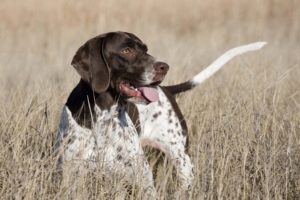 Development of the breed dates to the 1700s. History tells us that local farm dogs were bred to heavy and slow pointer dogs, brought from Spain to Denmark by travelling gypsies. Probably these Spanish pointers were also ancestors of the English Pointer. Looking at George Stubbs’ Spanish Pointer, one can see the heavy head and neck characteristic for these Spanish dogs. Looking at the Gammel Dansk Hønsehund, it is obvious that, apart from the Spanish pointer, another breed was involved in its development: the Bloodhound. The Gammel Dansk has a superior nose and is therefore used for tracking wounded deer as well. Slight drooping of the lower eye rim is another characteristic that reminds us of the Bloodhound. A German breed that resembles the Gammel Dansk is the German Shorthaired Pointer, not only in appearance but in how they work. There is clearly some relation to the Bracco Italiano, as well. The word “Hønse” can be translated as “bird,” hence the name Old Danish Bird Dog.
Development of the breed dates to the 1700s. History tells us that local farm dogs were bred to heavy and slow pointer dogs, brought from Spain to Denmark by travelling gypsies. Probably these Spanish pointers were also ancestors of the English Pointer. Looking at George Stubbs’ Spanish Pointer, one can see the heavy head and neck characteristic for these Spanish dogs. Looking at the Gammel Dansk Hønsehund, it is obvious that, apart from the Spanish pointer, another breed was involved in its development: the Bloodhound. The Gammel Dansk has a superior nose and is therefore used for tracking wounded deer as well. Slight drooping of the lower eye rim is another characteristic that reminds us of the Bloodhound. A German breed that resembles the Gammel Dansk is the German Shorthaired Pointer, not only in appearance but in how they work. There is clearly some relation to the Bracco Italiano, as well. The word “Hønse” can be translated as “bird,” hence the name Old Danish Bird Dog.
Interest in this national breed grew during the Second World War. Thanks to a few enthusiasts, the Hønsehund became quite popular after the war.
Morten Bak and the Gypsy Dogs
Morten Bak, a salesman from Glenstrup (Jutland), has to be mentioned in any story about the Gammel Dansk Hønsehund. In 1710, he was supposedly the first to cross “gypsy dogs” with local farm dogs to establish a pure breed of piebald white-and-brown dogs – the old name Bakhund is still sometimes used. Breed historians disagree about Bak’s foundation stock. Some state that the gipsy dogs (i.e., Spanish pointers) had bloodhound blood; others thought that the local farm dogs had French bloodhound blood because they were excellent tracking dogs, which is why local farmers called their white-and-brown dogs bloodhounds.
Johannes Matzen, a cabinetmaker from Nystad, is another well-known name in the breed’s history. His great-grandfather, Peder Christensen, worked the breed in the 18th century and continued to do so when he moved to Lolland (an island in the south of Denmark) in 1780. His son, Johannes Matzen’s grandfather, also owned the Gammel Dansk, until his death in 1893. Because of the family’s many years of interest in these dogs, Johannes Matzen had pedigrees of the breed going back to the end of the 19th century. Johannes served the breed club – founded in 1947 – as secretary and treasurer from 1947 to 1963. In 1960, the FCI recognized the breed.
Writer and Poet
Steen Steensen Blicher (1782-1848) is a well-known Danish writer and poet who portrayed the people of Jutland with humour, irony and melancholy. He grew up in close contact with nature and the peasant life of the moor areas of Jutland. Later, he became a person, like his father, but his main interests were hunting and writing. Being unhappily married, Blicher lived an outdoor life, walking, hunting and talking to farmers and gipsies. Peder Christensen was one of his hunting friends on the big fields and in the woods of Guldborgsland. When he left for Jutland, the writer-poet took several of the white-and-brown dogs with him. In 1814, he was offered a Gammel Dansk as a present and others were sent to him when he was working as a priest in Thorning. Blicher was photographed with his dogs, but unfortunately, I haven’t been able to find a single photo of the man and his dogs. I have seen, however, a painting, dated 1866, of Christen Dalsgaard (1824-1907), showing Blicher in the field, accompanied by several gipsies and his brown-and-white gun dog of Gammel Dansk type.
Progress
In the 19th century, the Gammel Dansk Hønsehund was being bred on several Danish estates, such as those on the islands Lolland, Falster and Fyn. It is said that around 1855, a number of dogs were sent to Germany. It is believed that they were used there in the development of the German Wire-haired Pointer.
Christian Bansen, a beer salesman, did a lot for the breed in the 1940s and was also the first chairman of the Danish breed club, from 1947 (the start of the club) until 1954. In 1949, the breed club had 25 members; 509 puppies were registered in 1983.
In November 1947, an exhibition was held in the city of Odense; 32 dogs were entered, but some were not of the right type and looked like mutts. Between 40 and 50 dogs were entered at a show in June 1948, also in Odense, among them were many youngsters. The breed had made progress; about 20 dogs were classified as typical for the breed. Two of them belonged to Christian Bansen from Ærø, one to Johannes Matzen from Nysted.
A Good and Clever Friend
Today the Gammel Dansk Hønsehund is still a valuable pointer dog, especially on birds. He has great stamina and is a friendly family dog as well as a good working dog. Hunting, he works rather slowly, but always maintains contact with the hunter. Danish owners say that the Gammel Dansk is a clever and good friend. Unlike many other breeds, there is a considerable difference between the male and female. Males are powerful and strongly built. The bitches are characterized as lighter, more spirited and capricious. Throatiness is a hallmark of the breed (another inheritance of the Bloodhound), but should not be exaggerated. Very shy behaviour is an eliminating fault because the standard requires determination and courage. The words “muscular,” “powerful” and “strong” appear many times in the breed standard that dates from 1998.
The Gammel Dansk is recognized by the FCI in Group 7, Pointer Dogs, Continental Pointer Dogs, Braque type.
The Gammel Dansk in Short:
Origin: 18th-century Denmark
Original purpose: Hunting dog
Description: Medium-sized, rectangular dog, strongly built. The head is short and wide without a pronounced stop. The occiput is prominent and clearly visible from any angle. The deep flews contribute to the characteristics of the head. The jaws are powerful with a regular complete scissor bite. The medium-sized, dark brown eyes are neither sunken nor prominent. Considering the origin of the breed, slight drooping of the lower eye rim is tolerated, but should not be encouraged. The ears are set rather low and are slightly rounded at the ends; the front edge should hang close to the cheek.
The neck is muscular; the body has a deep and wide chest and short, wide and muscular loins. A well-developed fore chest is most desirable. Forequarters and hindquarters are strong, straight and parallel. Both front feet and hind feet are strong, well-arched and with tough pads. The tail is set somewhat high rather than low and is fairly wide at the base, tapering toward the end. Docking is not allowed. The gait has a good drive from behind; a good, high head carriage is desirable.
The breed’s coat is short and dense and must cover the body entirely. Coat colours are white with brown markings and a few large or many small brown freckles on the white. The brown may vary, but brown to dark-brown is preferred.
Serious faults are a too-pronounced stop, rib cage too flat or barrel-shaped and a snippy muzzle. Some eliminating faults are an undershot or overshot jaw; three-quarters of an inch (two centimetres) above or below the size limit; and entropion, ectropion and distichiasis.
The Gammel Dansk conveys the impression of a quiet and stable dog and is suited for small as well as large hunting grounds.
Height/weight: Dogs 21 to 24 inches (54 to 60 centimeters), above 22 inches (56 centimeters) preferred; bitches 20 to 22 inches (50 to 56 centimeters), above 20.5 inches (52 centimeters) preferred). Weight 57 to 77 pounds (26 to 35 kilograms).
Information: Danish breed club, in Danish
